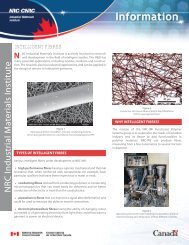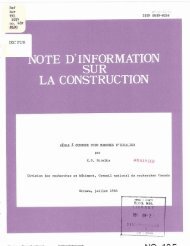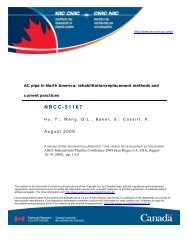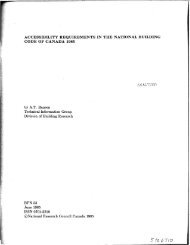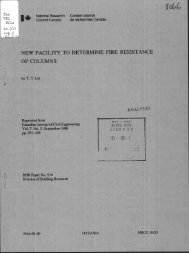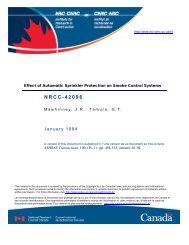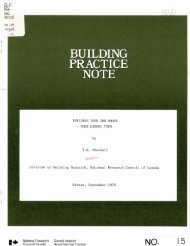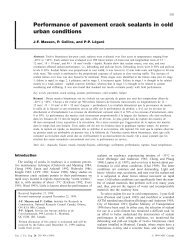Traffic-induced building vibrations in Montréal - National Research ...
Traffic-induced building vibrations in Montréal - National Research ...
Traffic-induced building vibrations in Montréal - National Research ...
Create successful ePaper yourself
Turn your PDF publications into a flip-book with our unique Google optimized e-Paper software.
Hunaidi and Tremblay 7511989) and a multiplication factor of 2. This results <strong>in</strong> a satisfactoryacceleration value (rms) of 0.01 m/s 2 , which is twicethe perception threshold of the most sensitive people. The rmsor rmq values should be calculated us<strong>in</strong>g a 2 s <strong>in</strong>tegration timeover the high amplitude portion of acceleration signals.• Method II: Peak acceleration evaluated with respect to thebase value of 0.007 m/s 2 specified by ISO 2631/2 (ISO 1989)and a multiplication factor of 30 together with multiplicationfactors recommended by ISO 2631/2 for the number and durationof events.In the above two methods, acceleration signals need to befrequency-weighted accord<strong>in</strong>g to ISO 8041 (ISO 1990b). If,on the other hand, velocity signals are measured and the frequencycontent <strong>in</strong> the signals is mostly above 8 Hz, frequencyweight<strong>in</strong>gis not needed — humans respond equally to<strong>vibrations</strong> at frequencies at or above 8 Hz. For velocity signals,the base values to be used <strong>in</strong> methods I and II are 0.1 mm/s(rms) and 0.14 mm/s, respectively.Potential for <strong>build<strong>in</strong>g</strong> damageIn some cases, owners of residential homes may make claimsabout vibration-<strong><strong>in</strong>duced</strong> <strong>build<strong>in</strong>g</strong> damage such as cracks <strong>in</strong>walls and ceil<strong>in</strong>gs, separations of masonry blocks, or cracks <strong>in</strong>the <strong>build<strong>in</strong>g</strong> foundation. Although vibration levels <strong>in</strong> <strong>build<strong>in</strong>g</strong>s<strong><strong>in</strong>duced</strong> by road traffic are rarely high enough to be the directcause of damage, they could contribute to the process of deteriorationfrom other causes. Build<strong>in</strong>gs usually have residualstra<strong>in</strong>s <strong>in</strong> their components as a result of uneven soil movement,moisture and temperature cycles, poor ma<strong>in</strong>tenance, and(or) past renovations and repairs. Therefore small vibrationlevels <strong><strong>in</strong>duced</strong> <strong>in</strong> <strong>build<strong>in</strong>g</strong>s by road traffic (and similarly byother man-made <strong>vibrations</strong> such as blast<strong>in</strong>g and pile driv<strong>in</strong>g)could trigger damage by “topp<strong>in</strong>g up” residual stra<strong>in</strong>s. Consequently,it is difficult to establish a vibration level above whichtraffic-<strong><strong>in</strong>duced</strong> vibration may cause <strong>build<strong>in</strong>g</strong> damage. It can beargued that such damage might be triggered or caused by activities<strong>in</strong> the home such as jump<strong>in</strong>g on stairs or floors andslamm<strong>in</strong>g doors, which can <strong>in</strong>duce vibration levels higher thanthose <strong><strong>in</strong>duced</strong> by road traffic. On the other hand, it could beargued that activities <strong>in</strong> <strong>build<strong>in</strong>g</strong>s cause local and less severedeformation patterns <strong>in</strong> <strong>build<strong>in</strong>g</strong>s compared to those caused bystress waves <strong>in</strong> the ground <strong><strong>in</strong>duced</strong> by traffic. Also, when<strong>build<strong>in</strong>g</strong>s are subjected to vibration for extended periods, as for<strong>vibrations</strong> caused by road traffic, the possibility of fatiguedamage exists if the <strong><strong>in</strong>duced</strong> dynamic stresses are high enough.In addition to damage caused directly by vibration, it should beacknowledged that there is a potential of <strong>in</strong>direct damagecaused by differential movement due to soil densification. Thelatter is particularly known to happen when loose and watersaturatedcohesionless soils are subjected to vibration.In view of the above remarks, it should not be surpris<strong>in</strong>gthat controversy still cont<strong>in</strong>ues to surround the issue of vibration-<strong><strong>in</strong>duced</strong><strong>build<strong>in</strong>g</strong> damage. Nonetheless, several countrieshave adopted standards that provide guidance on the evaluationof the effect of vibration on <strong>build<strong>in</strong>g</strong>s — no such nationalstandards have yet been adopted <strong>in</strong> Canada; some prov<strong>in</strong>ceshave, however, adopted guide values for <strong>vibrations</strong> <strong><strong>in</strong>duced</strong> byblast<strong>in</strong>g, e.g., Ontario (M<strong>in</strong>istry of the Environment 1978).Vibration levels measured <strong>in</strong> this study for transit buseswere evaluated to determ<strong>in</strong>e their potential for <strong>build<strong>in</strong>g</strong> damage.The follow<strong>in</strong>g standards and criterion were used:— German standard DIN 4150 (DIN 1984),— Swiss standard SN 640 312 (ASHE 1978),— British standard BS 7385 (BSI 1993), and— U.S. Bureau of M<strong>in</strong>es (USBM) criterion (Sisk<strong>in</strong>d et al.1980).These standards provide guide values <strong>in</strong> terms of frequency-dependentpeak particle velocity measured <strong>in</strong> basementsnear foundation walls or on the ground close to<strong>build<strong>in</strong>g</strong>s (the German standard also provides values for uppermoststoreys). The probability of <strong>build<strong>in</strong>g</strong> damage due tovibration below the guide values is very small. The <strong>in</strong>ternationalstandard ISO 4866 (ISO 1990a), which also deals withthe measurement of <strong>vibrations</strong> and evaluation of their effectson <strong>build<strong>in</strong>g</strong>s, does not yet <strong>in</strong>clude such guide values (mostlikely due to the controversy that cont<strong>in</strong>ues to surround thisissue). Damage to <strong>build<strong>in</strong>g</strong>s is generally def<strong>in</strong>ed <strong>in</strong> the standardsas formation of cracks, fall<strong>in</strong>g away of plaster, the enlargementof cracks already present, and the separation ofpartitions or <strong>in</strong>termediate walls from load-bear<strong>in</strong>g walls. Forresidential <strong>build<strong>in</strong>g</strong>s of wooden construction and vibration ata frequency of 10 Hz or higher, the lowest guide value <strong>in</strong> thestandards is that specified by the Swiss standard at 5 mm/s.In this study, only acceleration time histories were measured.Velocity time histories were obta<strong>in</strong>ed by <strong>in</strong>directly <strong>in</strong>tegrat<strong>in</strong>gthe measured acceleration time histories <strong>in</strong> thefrequency doma<strong>in</strong>. In this process, acceleration time recordswere transformed <strong>in</strong>to the frequency doma<strong>in</strong> us<strong>in</strong>g a 1024-po<strong>in</strong>t fast Fourier transform (FFT) with 50% overlapp<strong>in</strong>g Hann<strong>in</strong>gw<strong>in</strong>dows. Then, FFT components below 2.5 Hz were setto zero to avoid low frequency drift<strong>in</strong>g, and those above 2.5 Hzwere divided by the correspond<strong>in</strong>g frequencies. The modifiedFFT spectrum was then <strong>in</strong>verse fast Fourier transformed(IFFT) to obta<strong>in</strong> velocity time records. Acceleration levels below2.5 Hz were extremely small (see the section on narrowbandspectra). Hence, errors <strong>in</strong>troduced by discard<strong>in</strong>gcomponents below 2.5 Hz are <strong>in</strong>significant.Peak particle velocities of <strong>vibrations</strong> <strong>in</strong> basements nearfoundation walls are listed <strong>in</strong> Table 10 for measurements made<strong>in</strong> this study for test buses at 50 km/h. It can be seen that peakparticle velocities are well below 5 mm/s, <strong>in</strong>dicat<strong>in</strong>g that thepotential for direct <strong>build<strong>in</strong>g</strong> damage was very small. The possibilityof <strong>in</strong>direct damage caused by uneven soil densificationwas ruled out for most compla<strong>in</strong>t sites <strong>in</strong> Montréal, as thedom<strong>in</strong>ant soil type is silty clay which is very unlikely to settlewhen subjected to vibration. F<strong>in</strong>ally, fatigue-<strong><strong>in</strong>duced</strong> damagewas also ruled out <strong>in</strong> view of the small vibration levels measured<strong>in</strong> this study.ConclusionsCharacteristics of traffic-<strong><strong>in</strong>duced</strong> <strong>build<strong>in</strong>g</strong> <strong>vibrations</strong> <strong>in</strong>Montréal, <strong>in</strong>clud<strong>in</strong>g transfer functions between <strong>vibrations</strong> <strong>in</strong>sideand outside <strong>build<strong>in</strong>g</strong>s, were determ<strong>in</strong>ed from detailedmeasurements and analysis at n<strong>in</strong>e compla<strong>in</strong>t sites. A typicaltransit bus and city truck were used. Exist<strong>in</strong>g standards wereapplied to evaluate human annoyance from <strong>build<strong>in</strong>g</strong> vibrationand the potential for <strong>build<strong>in</strong>g</strong> damage. Also, controlled testswere performed at a selected site to evaluate the effect of road© 1997 NRC Canada




